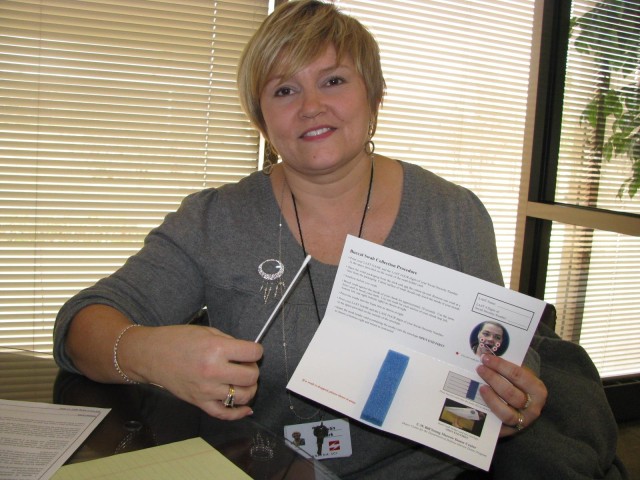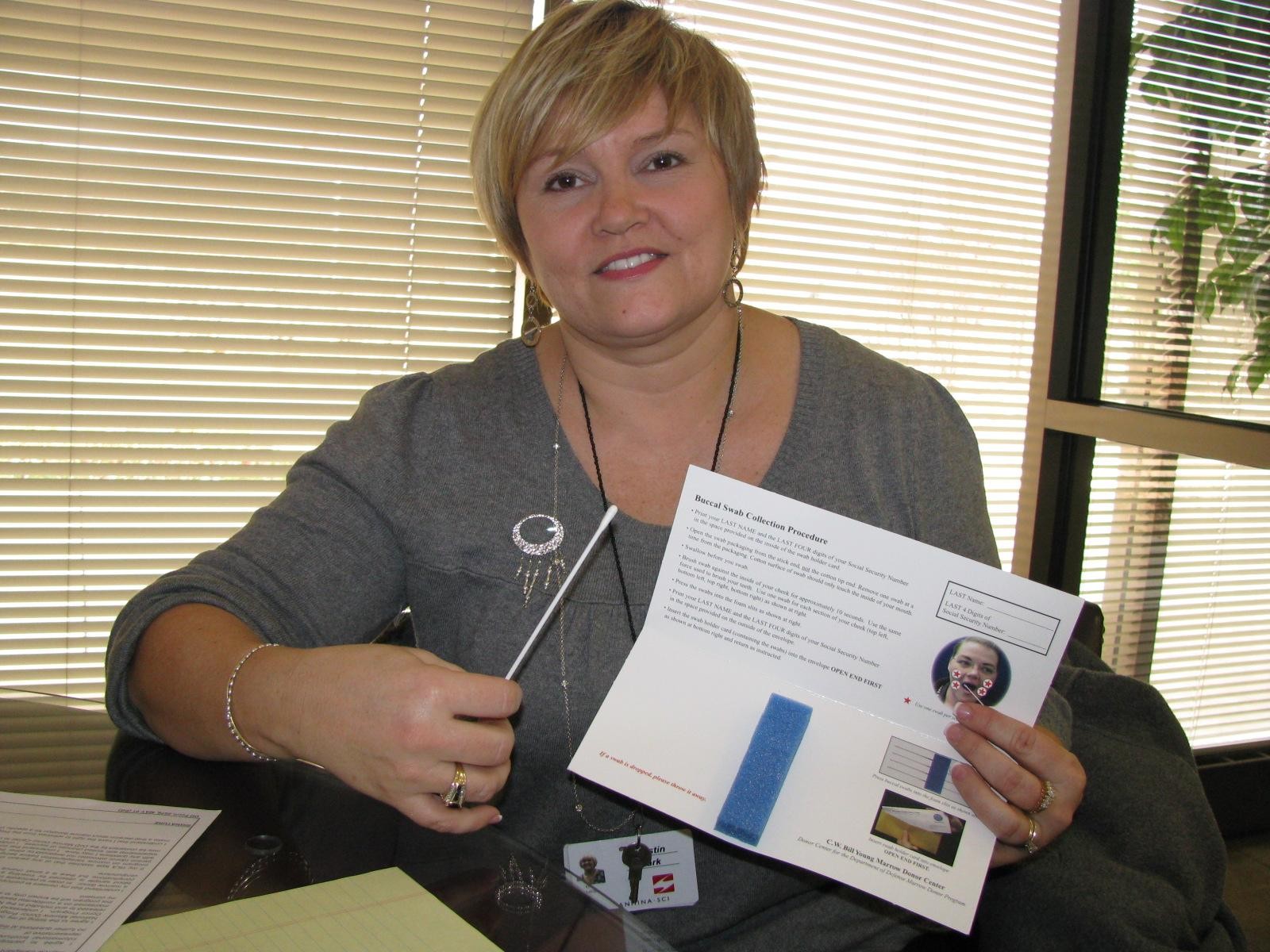
Kristin Clark has been a possible bone marrow donor since 1992.
Even with more than 15 years on the National Marrow Donor Registry, Clark has yet to receive a call that would match her up with a bone marrow recipient and give her a chance to save someone's life.
But she's not waiting on the sidelines for that call. Despite her own lack of personal testimony as a donor, Clark is carrying the message of bone marrow donation to the military. This retired Air Force master sergeant, who moved to Huntsville in August, is now seeking to set up a bone marrow donor registration program within the gates of Redstone Arsenal.
"Marrow donor drives are a great opportunity for Redstone Arsenal and tenant organizations in several ways - they give people a chance to save lives, they provide a positive image of the military and they create some great volunteer opportunities," she said.
Clark is a recruiter for the C.W. Bill Young Department of Defense Marrow Donor Program, which recruits potential bone marrow donors from within the DoD community around the world.
"It is so easy to become a potential bone marrow donor. And, if you are selected as a match for someone, it is also very easy to donate bone marrow," Clark said. "It's an easy way to help and to make a difference in someone's life. This is a great program."
There is a definite need for volunteers to sign up as bone marrow donors. Each year, more than 30,000 adults and children are diagnosed with leukemia or other fatal blood diseases and may require a lifesaving bone marrow or stem cell transplant if other treatments fail. Of those, more than 70 percent must search for a matching donor outside of their immediate family.
"It's hard to find a bone marrow match. But the odds get better as more and more potential donors are added to the registry," Clark said. "Patients who need a bone marrow transplant have already gone through chemotherapy, surgery, radiation and medications. By the time they need a bone marrow transplant from a stranger it is a pretty critical situation. It's a life-and-death situation."
Since the late 1980s, the National Marrow Donor Program has enabled more than 10,000 unrelated transplants using donors from their registry of more than 5 million volunteers. The NMDP has almost 100 donor centers around the country, one of which is the DoD marrow donor program. Active duty, National Guard, Reserve, dependents and DoD civilians are eligible to register at no charge under the DoD program.
"The DoD program is one of the NMDP's centers," Clark said. "But it doesn't cover one state or a region. It covers all military and DoD civilians nationwide."
In addition to its humanitarian mission, the DoD marrow donor program has a military contingency mission to provide immediate donor searches in the event of a mass casualty incident involving chemical agents or nuclear exposure that damages bone marrow.
Clark is available to conduct marrow donor registration drives on Redstone Arsenal. Organizations can contact her at 682-6407 or dodmarrow7@yahoo.com, or visit the national DoD site at www.dodmarrow.org or call 1-800-MARROW-3.
"Hosting a drive is simple and free," Clark said. "There is no charge to the hosting unit, the installation or those who register. All it takes is a date, time, location and publicity so that people know about it. We can do a drive where potential donors are scheduled to stop by and register or we can do a mass drive in a large room or auditorium where groups of 20 to 100 or more register at the same time. These drives work really well after a commander's call, training class or organizational meeting."
All it takes to register for the marrow donor program is a completed consent form and four oral swabs from inside a donor's mouth. Potential donors can swab their own mouth, reducing registration time to only a few minutes.
"It's so easy that you can actually register 200 people in under an hour," Clark said.
Once a donor completes registration, their information is sent to the National Marrow Donor Program in Minneapolis, where it is kept on file and checked during bone marrow match searches until the donor reaches age 60.
"There are 5.2 million people in the registry. And it is constantly searching for matches," Clark said. "Most people never hear anything from the registry. Finding a match is really a miracle."
If a donor is matched with a recipient, the donor is asked to give blood for further tests. If those tests confirm a match, then the donor receives an all-expense paid trip for themselves and a supportive family member or friend to Washington, D.C., where the donor undergoes a physical and further tests at Georgetown University Medical Center.
"At that point, they are told every detail of the procedure," Clark said. "If they agree, they sign some forms and then they go home to wait until the recipient is ready for the donation. It can take days, weeks, months to get the patient ready to accept bone marrow."
Once the donor is confirmed as a match and the patient is ready to receive the donation, the donor takes a second all-expense paid trip to Georgetown University Medical Center, where the donor is put under anesthesia and a needle is injected in their hip to remove bone marrow. The donor can then return home in a few days.
"They may be a little sore and have a little bruising. Their bone marrow replenishes in two weeks. And that's it," Clark said. "That's all they have to do to save someone else's life."
Bone marrow swabs are also tested for stem cell matches. If a donor is matched for a stem cell donation, the procedure only involves taking a few vials of blood from the donor's arm.
"The donor has to take some medications a few days in advance to boost up stem cells in the blood," Clark said. "But the stem cells are harvested with the donor completely awake. It is a minimally invasive procedure and well worth it."
Some donors and recipients eventually meet each other.
"Everything is kept private for a year," Clark said. "But the donor and patient can exchange letters and updates. After a year, if both agree, then the program will facilitate a meeting."
As an airman stationed at Peterson Air Force Base in Colorado, Clark conducted bone marrow registration drives at military installations in the seven-state Southwestern region.
"I would either go to the bases and conduct the drives, or I would train people at the bases to conduct the drives themselves," she said. "We can also do that at Redstone Arsenal. I can train volunteers to conduct the drives, and they would be provided with the consent forms, swabs, posters and other materials they need to conduct the drive. Or, I can train volunteers so that they can have a walk-in program scheduled once a week or once a month. The most important thing is getting the word out and letting everyone know."
Even though registration is easy, Clark said it was difficult during her eight years at Peterson Air Force Base to get a consistent schedule of bone marrow drives established because of deployments and transfers. She doesn't expect that problem at Redstone Arsenal because a more stable civilian work force will make it easier to grow the program.
"It's been several years since any bone marrow drives have been conducted at Redstone Arsenal," Clark said. "Once I find people and organizations who want to participate in the donor program, the rest will be easy."
Clark admits it can be challenging to find organizations or volunteers willing to be involved in the bone marrow program.
"It's difficult until people stop and think how easy it is to do and how big an impact it can have on someone else's life," she said. "A lot of times, the military has bigger priorities, especially if they are getting ready for a deployment or are undergoing training. They might think being a donor takes a lot of time. But really the excuses just don't fly when you realize how easy this is to do."
People who have had a personal experience with leukemia or other fatal blood diseases are often more interested in participating in the bone marrow program. Over the years, Clark has had two friends involved in the bone marrow program.
One of those friends is a former Air Force sergeant major who was diagnosed with leukemia after returning from Operation Desert Storm.
"Ten years ago he was told to get all us arrangements in order because it didn't look like he was going to live," Clark said. "But they finally found a donor match. And last year he met his donor."
Another friend - a lieutenant colonel at Peterson Air Force Base - provided bone marrow for a fellow officer.
"The patient he saved was a lieutenant at the time. After the bone marrow transplant, the donor helped to pin the recipient with his lieutenant colonel pin at his promotion," Clark said.
"I think any donor who goes through the transplant procedure will tell you it is well worth it to know you have saved someone's life. Sometimes a patient passes away even with a bone marrow transplant. But, even with a death, the donor has given the patient an extra year or two or maybe even only six months to be with their family and enjoy life."
Shipping of samples
The DoD MDP is the military's sole donor "center" for the, managed by the National Marrow Donor Program - this is a registry of millions who are willing to donate bone marrow or peripheral blood stem cells to save the life of a terminally ill patient. Unfortunately, the chances of a match between unrelated patients and donors is slim, but all too often, patients do not find a match within their family either and must hope for a miracle match from the registry.
.
One interesting thing to note -
Problems involving overseas travel or medications that keep DoD Soldiers and civilians from donating blood do not apply to marrow donor registration.
"I've done marrow donor registrations at the same time as blood drives," Clark said. "But there is a much better turnout when marrow donor registrations are done separate from blood drives because all the restrictions of a blood donor do not apply to a marrow donor."

Social Sharing